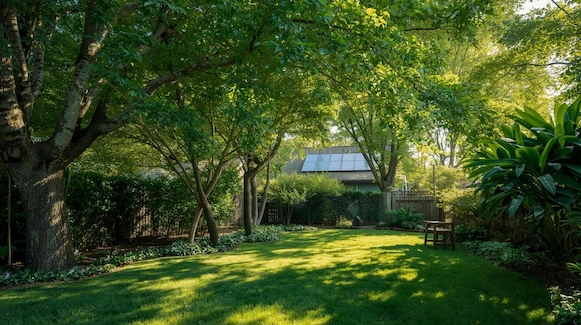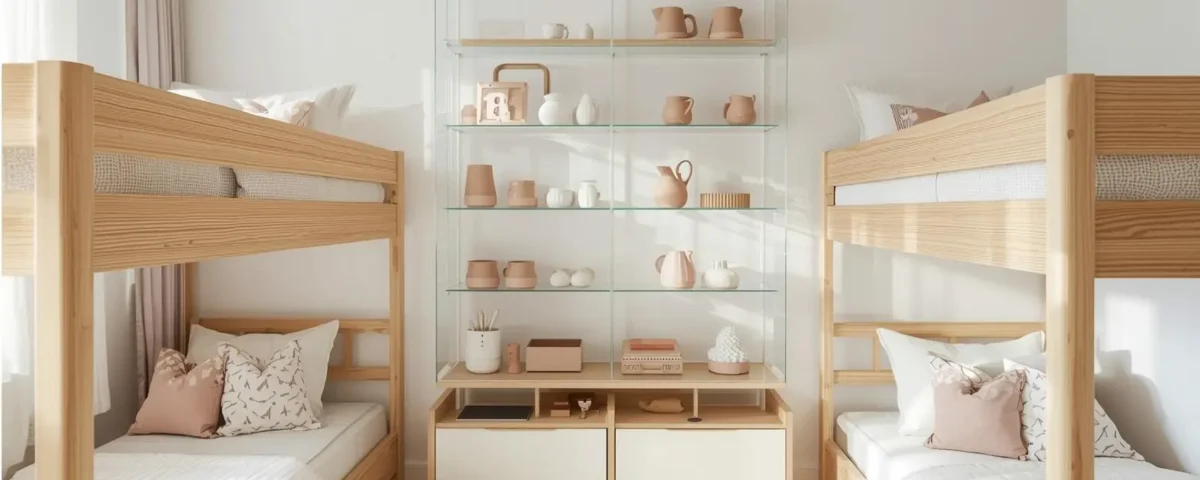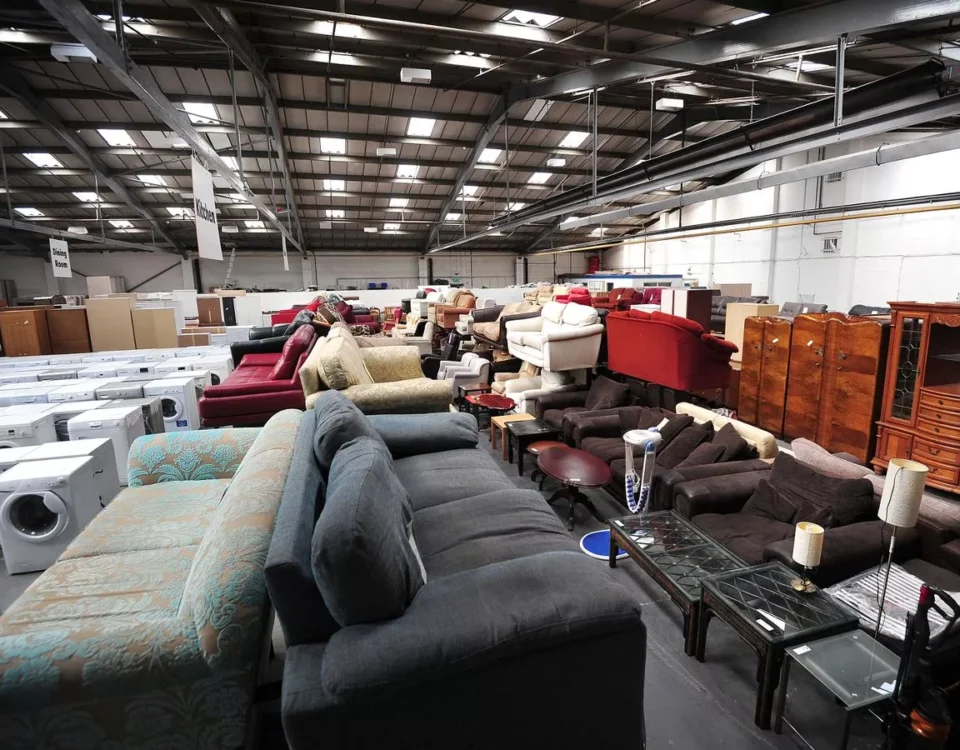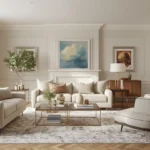
10 Living Room Makeovers to Transform Your Home in Style
September 17, 2025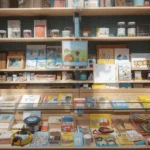
The Ultimate Guide to Meaningful Non-Toy Gifts for Kids
September 22, 2025Crafting a Safe and Stylish Kids' Sanctuary
Are you a parent struggling to create beautiful, functional spaces that your children will love, without compromising on safety or durability? You’re not alone. The constant tug-of-war between design dreams and practical realities think sticky fingers on furniture, toys scattered across the floor, or toddlers on the move can make decorating feel more stressful than inspiring.
But here’s the good news: creating a space that’s both stylish and safe isn’t just possible it can be surprisingly enjoyable.
Many parents want their home to reflect their personal style, but they also need it to serve as a nurturing, engaging environment for their kids. This guide is here to help you bridge that gap. From using the warmth and durability of natural wood, to incorporating kid-friendly glass décor and even decorative pitchers that double as functional art, you’ll find out how to curate living and bedroom spaces that feel thoughtful, inviting, and entirely family-friendly.
You’ll walk away with:
- Design tips that grow with your child
- Creative décor solutions using natural materials
- Simple but essential safety strategies
- Budget-friendly ideas that don’t sacrifice beauty
As a designer with a passion for creating cozy, modern family homes, I’ve helped countless parents turn chaos into calm without giving up on their dream interiors. This isn’t about making your home look like a showroom. It’s about helping you build a space that works, feels good, and grows with your family.
Let’s explore how to transform your child’s living and sleeping areas into safe sanctuaries that are as stylish as they are practical.
The Timeless Appeal of Wood in Kids' Decor
When it comes to designing safe, stylish spaces for children, wood remains one of the most beloved and reliable materials. It’s not just a design choice it’s a smart investment in both function and form.
Why Wood? Durability, Warmth, and Natural Aesthetic
From nursery cribs to teen bookshelves, wood effortlessly adapts to every stage of a child’s growth. Its natural beauty adds warmth and character to a space, while the tactile quality invites touch and connection essential for growing minds and hands. Whether you're crafting a cozy reading nook or furnishing a shared play-and-sleep area, wood provides an organic, grounding element that never feels outdated.
Beyond its appearance, wood is also a champion of longevity. Unlike plastic or flimsy alternatives, quality wood pieces can withstand rough play, constant movement, and even the occasional crayon masterpiece.
A Sustainable, Earth-Friendly Choice
Another reason wood continues to shine in modern kids' decor is its environmental edge. Sourced responsibly, wood is a renewable resource that supports sustainability a value many families are proud to pass on to their children.
To ensure you’re making the most responsible choice, opt for FSC-certified wood (Forest Stewardship Council), which guarantees the material was harvested with care for forests, wildlife, and local communities. Pair that with non-toxic finishes and you’ve got a decor solution that’s safe for your child and kind to the planet.
💡 Expert Tip: Always choose wooden furniture finished with low-VOC (Volatile Organic Compound) or zero-VOC finishes. Look for safety certifications like GREENGUARD Gold, which ensures the item meets strict chemical emission limits and is safe for indoor air quality.
Choosing the Right Wood for Kids’ Spaces
Not all wood is created equal. Depending on your budget, style, and usage, here’s how to choose what works best:
- Hardwoods like maple, oak, and birch: These are top choices for children’s spaces because of their durability and scratch resistance. Ideal for pieces that will see frequent use, like beds, bookshelves, or play tables.
- Softwoods like pine and cedar: A more affordable option, these woods bring a charming, rustic vibe. However, they’re more prone to dents and scratches better suited for decorative items or furniture that won’t face heavy wear.
- Engineered wood such as plywood or MDF (Medium-Density Fiberboard): These are cost-effective and versatile but can vary widely in quality. Always check that engineered wood products are formaldehyde-free or made with low-emission resins.
Think Beyond the Basics: Multi-Functional Wood Furniture
One of the smartest trends in kids' decor is multi-functional wooden furniture that can serve both living and bedroom spaces. This is especially helpful in smaller homes or shared spaces.
Some examples:
- Wooden storage benches that work as toy storage by day and reading nook seating by night.
- Modular wooden shelving units that evolve from displaying toys to storing books and schoolwork.
- Convertible cribs or toddler beds made from hardwood that grow with your child.
These smart pieces save space, reduce clutter, and add natural texture to the room all while remaining stylish and safe.
Integrating Wood Furniture & Decor
Wood can do more than build furniture. It can bring charm and cohesion to the entire design theme:
- Montessori-inspired wooden elements: Low, open shelves encourage independence and accessibility. Child-sized wooden tables and chairs invite kids to draw, read, or snack on their own terms.
- Wooden wall art or decorative shapes: Painted with non-toxic paints and securely mounted, they add playfulness and personality to the room without relying on plastic or overstimulating visuals.
- Wood flooring: Hardwood floors are ideal for kids’ rooms not only do they offer durability and timeless appeal, but they’re also easy to clean after spills or craft-time accidents. Add a soft area rug for warmth and comfort.
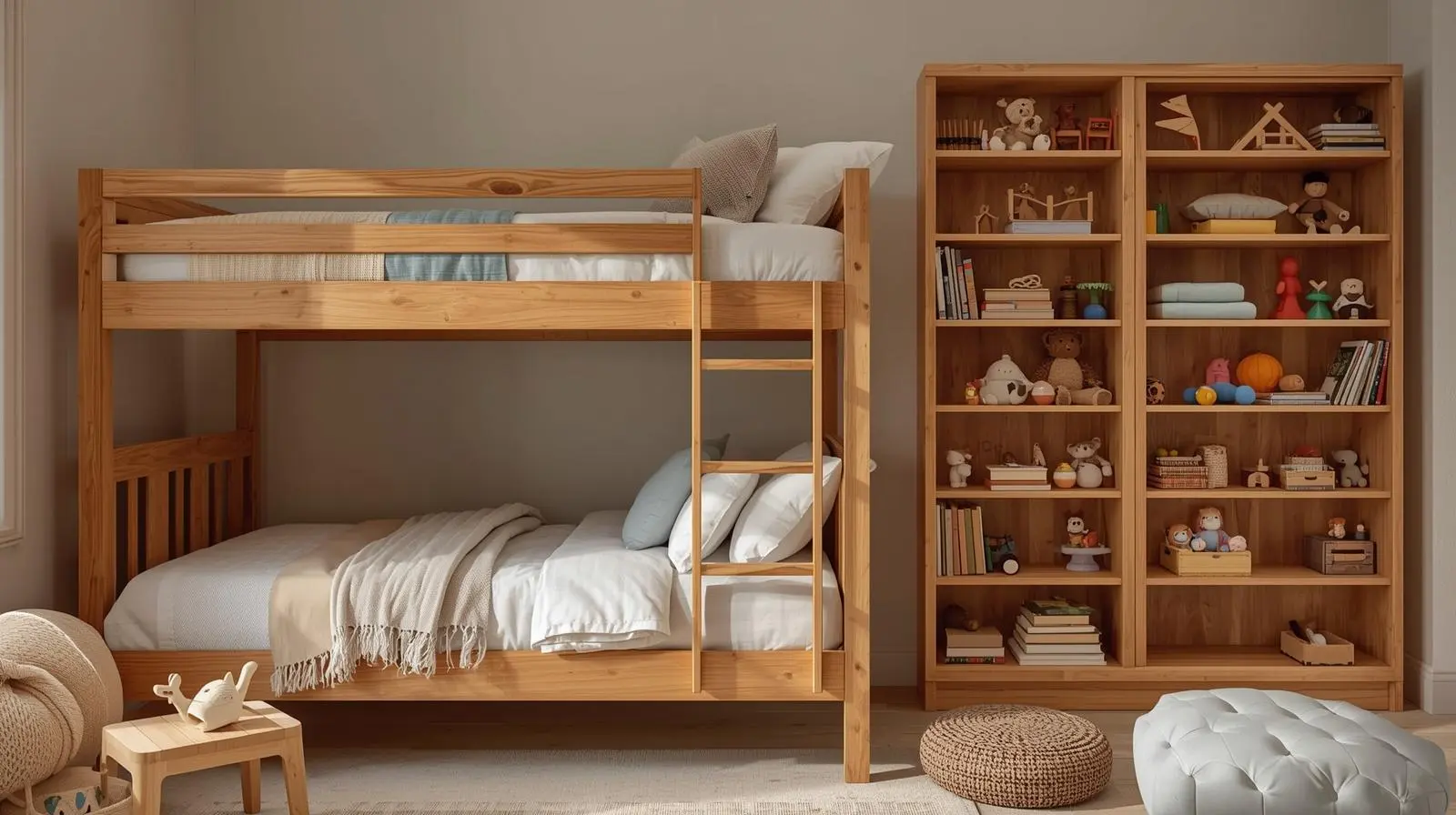
Incorporating Glass Safely and Creatively
Glass might not be the first material that comes to mind when designing kid-friendly spaces but when used thoughtfully and safely, it can add elegance, light, and texture to your child’s living or bedroom areas without compromising safety.
Addressing Safety Concerns Head-On
Let’s be honest: traditional glass in children's areas raises immediate red flags. Shattering risks, sharp edges, and breakability are all valid concerns. However, modern material advancements now offer a variety of safer glass alternatives that retain the look and feel of classic glass minus the danger.
According to child safety experts and pediatricians, the key lies not just in the type of glass used, but also in strategic placement and anchoring to minimize risks.

Safer Glass Alternatives for Kids’ Rooms
Not all glass is created equal especially when it comes to safety. Here are three smart material options that combine transparency and durability:
- Tempered Glass: This safety glass is heat-treated to increase strength. If it does break, it shatters into small, blunt pieces rather than sharp shards. Perfect for framed wall art or enclosed shelving.
- Acrylic (Plexiglass): Acrylic is a lightweight, shatter-resistant material that mimics the clarity of glass. It’s ideal for picture frames, DIY projects, and even tabletop protectors. Bonus: it’s also easier to drill or cut if needed.
- Polycarbonate: Even tougher than acrylic, this ultra-durable plastic is highly impact-resistant. It’s often used in protective gear and is an excellent choice for glass-like panels in playroom furniture or decor.
Strategic Placement for Glass Elements
The real secret to incorporating glass into child-friendly decor is placing it where little hands can’t reach, and using secure mounting or protective cases. Here’s how to do it smartly:
- High shelves or mantels: Use these elevated areas for decorative glass vases, jars, or enclosed terrariums always out of reach of children.
- Tall furniture with enclosed display areas: Want to showcase sentimental items or collectables? Place them behind tempered glass doors in a display cabinet and make sure that cabinet is securely anchored to the wall.
- Tempered glass within picture frames: Displaying family photos or your child’s artwork? Choose wall-mounted, tempered glass frames or opt for acrylic alternatives. Secure them tightly to the wall using child-safe mounting hardware.

Creative Ideas for Glass Decor
When done safely, glass (or its alternatives) can add sparkle, sophistication, and even sensory interest to your child's room. Here are some creative, safe ideas:
- Terrariums in shatterproof containers: Bring in a touch of nature with low-maintenance enclosed plant displays. Choose acrylic or tempered glass containers and place them on high shelves or inside cabinets.
- Decorative jars and bottles: Fill glass (or acrylic) jars with colourful beads, fairy lights, feathers, or shells. These work beautifully on floating shelves or inside locked cabinets for visual appeal without direct interaction.
- Framed wall art with glass or acrylic covers: Showcase your child’s rotating art projects in frames with safe coverings. This protects the artwork and adds a clean, gallery-style look to their room.
- Light-enhancing features: Try using acrylic panels in window-adjacent shelving or room dividers to reflect light and brighten the space, creating a more open, airy feel.
Product Recommendations Worth Exploring
To make your shopping easier, here are a few popular and parent-approved products
- Umbra Exhibit Wall Picture Frame Set – Comes with tempered glass and wall anchors; great for creating a modern gallery wall.
- Design House Stockholm Greenhouse Terrarium – A stylish and safe indoor plant enclosure made from tempered glass and wood ideal for shelves in older kids’ rooms.
- ArtToFrames Plexiglass Picture Frames – Lightweight, custom-size options with acrylic fronts, perfect for rotating children’s artwork safely.
IKEA FABRIKÖR Glass Cabinet Sturdy and lockable, this glass-and-metal cabinet is a favorite for safely displaying keepsakes out of reach.
With the right materials and thoughtful placement, glass can play a surprisingly versatile and safe role in children’s living spaces. Whether it’s highlighting your child’s creativity, showcasing cherished memories, or simply adding a reflective element to brighten the room, glass deserves a second look just with a safety-first mindset.
Lorem ipsum dolor sit amet, consectetur adipiscing elit, sed do eiusmod tempor incididunt ut labore et dolore magna aliqua. Ut enim ad minim veniam, quis nostrud exercitation ullamco laboris nisi ut aliquip ex ea commodo consequat. Duis aute irure dolor in reprehenderit in voluptate velit esse cillum dolore eu fugiat nulla pariatur. Excepteur sint occaecat cupidatat non proident, sunt in culpa qui officia deserunt mollit anim id est laborum.

Umbra Prisma Picture Frame, 5x7

ROBOTIME DIY Miniature House Kit Mini Green House Tiny Dollhouse Wooden Furniture Kit with LED
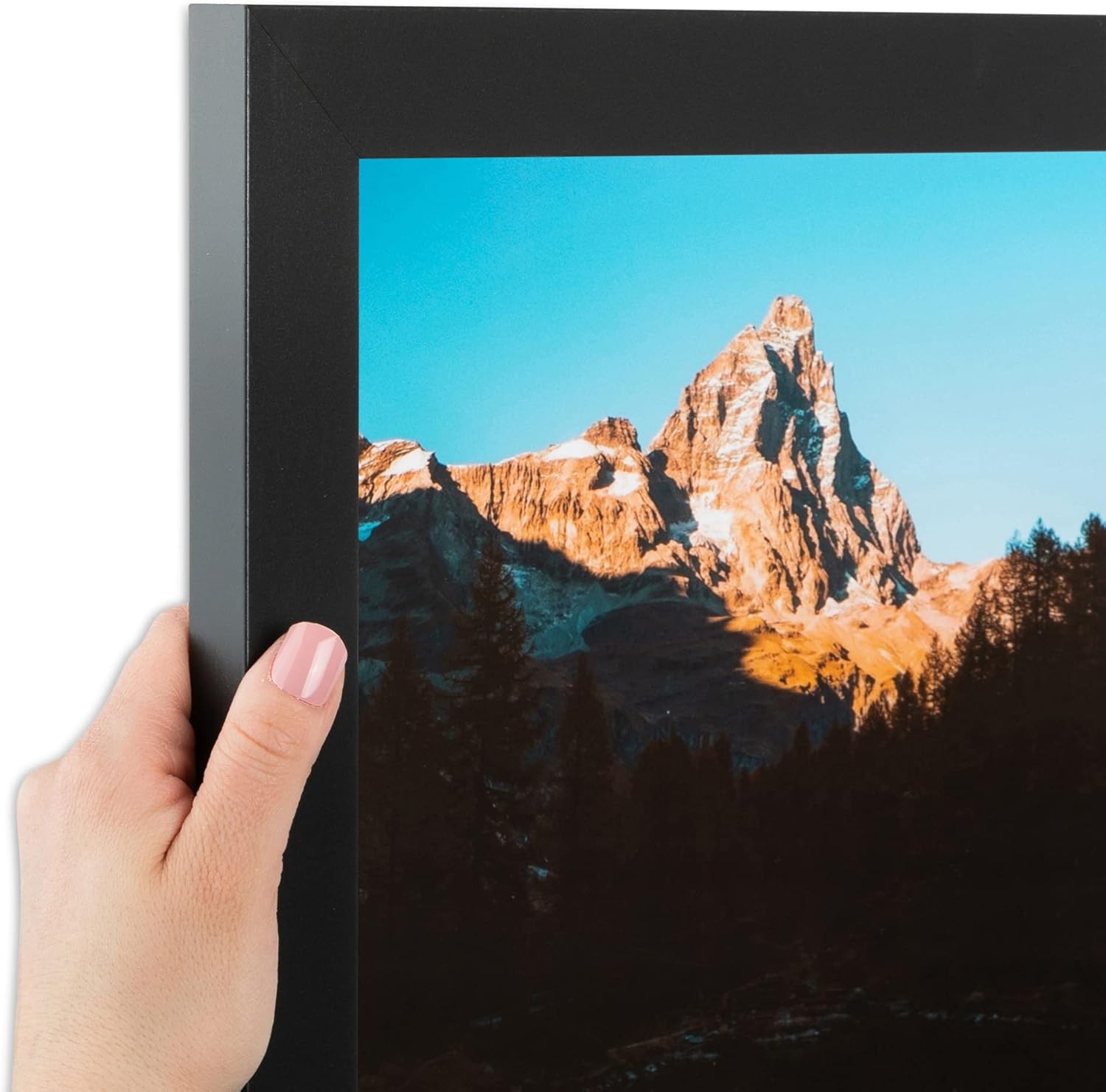
Display your favorite photos, posters, diplomas, or artwork in style with this 20x26 Satin Black Picture Frame. Crafted from durable MDF with a sleek 1.25" wide profile and a .75" depth, this versatile frame is designed to complement any décor. The smooth satin black finish works beautifully with both color and black-and-white prints, making it perfect for galleries, offices, or home use. Each frame comes with Plexiglass for clarity and protection plus a wire hanging set for easy wall mounting. Measuring 22x28" overall, it is carefully constructed to meet high industry standards and built to last. Whether you’re showcasing a cherished memory, an art print, or a certificate, this elegant gallery-style frame enhances your piece while maintaining a clean, modern look—an ideal choice for personal use or as a thoughtful gift.
-
Premium Quality Frame – Made from durable MDF with a satin black finish for a clean, modern look.
-
Perfect Fit – Holds 20x26 inch prints; finished size is 22x28 inches with a 1.25" wide profile.
-
Protective Plexiglass – Includes Plexiglass front to keep your photo, poster, or artwork safe.
-
Ready to Hang – Comes with a wire hanging set for secure and easy wall mounting.
-
Versatile Style – Ideal for photos, posters, diplomas, certificates, and gallery displays.
Pitchers: Versatile Decor Beyond the Kitchen
Pitchers may be most commonly associated with pouring drinks at the table but in the world of interior design, they hold far more creative potential. With the right styling and a bit of imagination, pitchers become functional, beautiful additions to kids’ living and bedroom spaces, blending practicality with personality.
Beyond the Vase: Pitchers as Functional Decor
Think of pitchers as the unsung heroes of home decor. Their gentle curves, wide openings, and varied materials make them the perfect canvas for both artistic and practical expression. Unlike traditional vases or baskets, pitchers bring a homey, approachable charm that softens a space while still serving a purpose.
From rustic ceramic to playful acrylic, pitchers can be styled to suit modern, vintage, or eclectic themes, making them highly adaptable. Best of all, they offer a unique organizational twist for family homes, especially when used to contain small, often messy items like pencils, craft supplies, or even mini toys.
🎨 Expert Tip: Don’t limit pitchers to floral arrangements. Use them as stylish catch-alls for your child's creative supplies, snacks, or bedtime books. This promotes both accessibility and tidiness and makes cleanup easier for little ones.
Creative Uses for Different Pitcher Types
Let’s break down the design possibilities and functions of various pitcher materials:
Ceramic Pitchers: Warm & Decorative
- These are ideal as standalone decor pieces on shelves or dressers, adding texture and warmth.
- Use them to display dried floral arrangements, twigs, or seasonal branches for an organic touch.
- Larger ceramic pitchers can hold soft toys, plush animals, or wooden blocks, especially in reading corners or near the bed.
Tip: Opt for pitchers with a matte finish or soft glaze in muted tones these blend seamlessly into child-friendly design schemes without overpowering the space.
Metal Pitchers: Industrial Charm with Utility
- Galvanized steel or enamel pitchers bring an industrial or farmhouse vibe to your child’s space.
- Use them on desks or art tables to hold paintbrushes, crayons, rulers, or scissors.
- Repurpose as a quirky indoor planter just ensure drainage by placing a small pot inside or adding rocks at the base.
Bonus: Metal pitchers are typically lightweight yet durable, making them a practical choice for frequently used items.
Glass Pitchers (Tempered or Acrylic): Light-Reflecting & Safe
- With safety in mind, only use tempered or acrylic pitchers in children’s spaces and always place them out of reach.
- Fill with colorful pom-poms, sensory beads, feathers, or even marbles for a calming, visual focal point.
- A wide-mouthed acrylic pitcher can double as a mini terrarium, offering a fun DIY opportunity for older kids.
Safety Reminder: Place glass pitchers on high shelves or inside enclosed cabinets to avoid accidental tipping or breakage.
DIY & Repurposing Ideas: Personalize with Purpose
One of the best things about using pitchers in your decor is how easily they can be personalized to reflect your child’s style or interests. A simple, inexpensive pitcher can become a one-of-a-kind showpiece with just a little creativity.
- Paint It: Let your child choose the color scheme and help you paint a basic ceramic or metal pitcher using non-toxic paints. This becomes both a craft activity and a functional storage piece.
- Decoupage or Stickers: Decorate pitchers with patterned paper, washi tape, or vinyl decals to match room themes like animals, space, or nature.
- Textural Sensory Displays: Choose pitchers with interesting surfaces like hammered metal or carved ceramic for tactile exploration. Place them on high shelves where kids can look but not touch, creating a "Sensory Safe Haven" a mini display designed to soothe through sight and texture.
🧠 Creative Bonus: Rotate pitcher displays seasonally. In spring, use them to hold fresh greenery or faux flowers. In fall, fill with mini pumpkins or pinecones. It’s an easy way to keep your child’s environment engaging and fresh without a major redesign.
With the right approach, pitchers prove that decor can be both beautiful and useful even in kids’ rooms. Whether they’re helping corral clutter or bringing an artistic touch to a shelf, these everyday items have the power to bring both order and inspiration to your family’s daily routine.
Design Principles for Kid-Friendly Spaces
Designing a space for children is about far more than choosing a fun theme or throwing in some colorful furniture. The best kid-friendly rooms are thoughtfully planned to grow with the child, support their development, and adapt to daily life mess and all.
Let’s break down the core design principles that will help you create safe, beautiful, and truly livable environments for your kids.
Age-Appropriateness and Adaptability (Grow-With-Me Design)
Children grow fast and their needs change even faster. What works for a toddler won’t suit a curious 7-year-old or an independent pre-teen. That’s why choosing adaptable, modular decor and furniture is a wise investment.
Look for:
- Convertible beds that start as cribs and expand into full-size beds.
- Adjustable desks and chairs that support proper posture at every age.
- Modular shelving systems that can be rearranged, expanded, or repurposed over time.
🌱 Grow-With-Me Idea:
Start with a low, child-sized bookshelf filled with board books and toys. As your child grows, transition it into a reading nook with more sophisticated books, a lamp, and framed art above it. Add a comfy chair, and the space transforms from a play zone to a homework corner without buying new furniture.
These kinds of evolving solutions give your decor longevity and flexibility, saving time, money, and effort as your family grows.
Color Psychology and Theme Integration
Colors do more than make a room look pretty they influence mood, behavior, and function.
- Use cool, calming tones (soft blues, muted greens, gentle greys) in sleep areas to promote rest.
- Opt for stimulating, energetic colors (yellows, oranges, bright pastels) in play or creative zones to encourage movement and imagination.
🎨 Expert Tip: Involve your child in the color selection process. Whether it's choosing a paint swatch, bedding pattern, or wall art, this empowers kids and helps them feel connected to their space, boosting confidence and creativity.
For themes, avoid anything too narrow (like a single cartoon character). Instead, choose timeless, interest-based themes like nature, animals, space, or art that can be updated with minimal changes as your child’s tastes evolve.
Maximizing Space and Minimizing Clutter
Even the most beautifully designed room won’t function well if it’s overrun with clutter. Smart space management is essential especially in shared or small spaces.
Top clutter-busting solutions:
- Multi-functional furniture: Think storage benches, loft beds with built-in drawers, or desks that fold away when not in use.
- Vertical storage: Use wall-mounted shelves, over-the-door organizers, or pegboards for art supplies and accessories.
- Under-bed storage: Ideal for seasonal clothes, extra toys, or craft bins.
📦 Expert Tip: Incorporate multi-purpose furniture wherever possible. A wooden bench with hidden storage can be used in both bedroom and living areas perfect for hiding toys, shoes, or books in seconds.
Smart storage not only keeps the room looking tidy, it teaches kids how to organize their belongings independently, building life skills along the way.
Lighting Strategies: Bright Spaces That Feel Good
Lighting can transform how a room looks and feels. For children’s spaces, the goal is to create a warm, welcoming atmosphere while supporting functionality.
- Natural light: Always prioritize this. Use sheer curtains to soften harsh sunlight without blocking it. Placing mirrors (safely mounted) opposite windows can help reflect light and brighten the room.
- Layered lighting: Combine ambient (overhead), task (desk or reading), and accent lighting (string lights, wall sconces) to create a flexible space that works day and night.
💡 Expert Tip: Glass or acrylic decor elements like picture frames or pitchers filled with soft lights can reflect natural and artificial light, adding a soft glow to the room while also acting as charming accents.
Creating Defined Zones: A Room That Works for Everything
Children thrive when their environments are structured and intentional. Define clear zones within their rooms to create a sense of order and function.
- Play Zone: Durable, wipeable flooring (wood or large area rugs), labeled toy storage, open floor space.
- Sleep Zone: Soft, layered bedding, dimmable lighting, calming color palette.
- Study/Creative Zone: A well-lit desk or art table, pegboard organizers, task lighting, comfortable seating.
🧩 Unique Angle:
Think “Beyond the Nursery: Designing a Unified Kids’ Zone.” Instead of treating the living room and bedroom as separate silos, try blending both using versatile wood furniture (like matching storage units), decorative glass frames, and pitcher-based organizers that travel seamlessly between spaces. This creates a cohesive, shared environment where family activities and personal downtime coexist beautifully.
Visual Inspiration: Try an Interactive Mood Board Tool
Sometimes, the biggest challenge is visualizing how everything fits together. Imagine a simple, drag-and-drop Interactive Room Planner or Mood Board Builder, where you can experiment with:
- Modular wood furniture
- Tempered glass accents
- Functional pitcher decor
- Calming or energetic color palettes
- Real-life room layouts based on your child’s age and needs
Such a tool would empower parents to test layouts, color combos, and decor pairings before committing making designing fun instead of frustrating.
Designing kid-friendly spaces is not about making the room look “childish.” It’s about crafting a place where your child feels safe, inspired, and proud to call their own. By following these timeless principles, you can create a room that’s as functional as it is fabulous and one that will evolve beautifully as your child grows.
Curated Product Roundup & Buyer’s Guide
Finding the right pieces for your child’s living and bedroom spaces can be overwhelming. To make things easier, we’ve put together a carefully curated selection of recommended products that blend style, function, and child safety so you can decorate with confidence.
Each item below has been selected for its practicality, aesthetic appeal, and parent-approved safety features. Whether you're furnishing a playroom, updating a shared living space, or refreshing a bedroom, these picks are designed to grow with your child and bring calm, beauty, and order to their environment.
|
Product Category |
Example Product |
Key Features |
Safety/Material Notes |
Why We Recommend It |
|
Wooden Furniture |
Montessori-style Low Bookshelf |
Open shelving; child-height; encourages self-selection of toys/books |
FSC-certified birch plywood; non-toxic, lead-free finish; rounded corners for injury prevention |
Promotes independence and organization in a child-safe format; blends into both bedrooms and shared family areas |
|
Glass Decor (Safe) |
Tempered Glass Picture Frame |
Comes with wall mount and easel back; clean lines for modern or classic styling |
Uses tempered safety glass (breaks into dull pieces); secure frame back; ideal for mounting out of child’s reach |
A great way to display art or family photos in a kid’s room without sacrificing safety or style |
|
Acrylic Decor |
Shatterproof Acrylic Vase |
Transparent; lightweight; fits in with any decor style |
Made from BPA-free acrylic; completely shatterproof; smooth edges |
Adds visual interest and light reflection safely great for flowers, pom-poms, or sensory items |
|
Versatile Pitchers |
Decorative Ceramic Pitcher |
Wide mouth; classic design; doubles as storage |
Lead-free glaze; heavy base prevents tipping; suitable for non-liquid storage like pencils or brushes |
Combines charm with function perfect for art supplies, dried flowers, or small toys on a shelf or desk |
|
Multi-functional Wood |
Wooden Storage Bench |
Built-in storage beneath seating; ideal for small spaces |
Made from solid pine or oak; soft-close hinges; painted with low-VOC, non-toxic finish |
Helps manage clutter in playrooms or bedrooms while offering a cozy reading or seating spot |
|
Wooden Wall Decor |
Floating Wooden Wall Shelves |
Clean, minimalist design; available in various sizes |
Secure mounting hardware included; made from solid wood (e.g., oak); coated with non-toxic sealant |
Great for displaying books, toys, or decor out of reach while creating functional zones (e.g., reading corners, art displays) |
Bonus Tips for Buying Safely and Smartly:
- Always look for certifications like FSC (Forest Stewardship Council) for wood, GREENGUARD Gold for finishes, and BPA-free labels for plastics and acrylic.
- Check weight limits and anchoring instructions for shelving, benches, and tall furniture especially for use in play-heavy environments.
- When buying glass or acrylic items, consider how and where they’ll be placed (e.g., avoid placing glass near beds or play zones unless enclosed or high-mounted).
- For regional relevance, check trusted retailers like IKEA, Pottery Barn Kids, Crate & Kids, Amazon, or local eco-conscious furniture makers in your area.
🛍️ Pro Parent Tip: If you're shopping online, read reviews from other parents they’re often the best source of practical, day-to-day insight on how items hold up over time in real homes.
DIY & Budget-Friendly Decor Ideas
Smart decorating doesn’t have to break the bank. With a little creativity and a few supplies, you can transform everyday materials into meaningful, child-friendly decor. These ideas blend hands-on projects, upcycled treasures, and budget-conscious choices all while making your child’s space more personal and engaging.
🛠️ Repurposing & Upcycling for Kids’ Spaces
Why buy new when you can reimagine what you already have? Repurposing items is not only eco-friendly, but it also allows you to customize decor to fit your child's personality and evolving interests.
- Old pitchers become unique bookends, vases, or craft holders.
- Glass jars and bottles turn into beautiful, safe decorative elements (when placed wisely).
- Reclaimed wood becomes personalized growth charts or floating shelves.
💡 Expert Tip: Rotate toys and decor every few weeks. This keeps the room feeling fresh and helps kids rediscover forgotten toys, avoiding overstimulation.
🎨 DIY Wood Projects for Kids’ Spaces
Wood is a timeless, natural material that’s safe, sturdy, and endlessly customizable. These DIY ideas are great for weekends with the kids or solo crafting time.
- Simple Wooden Blocks: Cut, sand, and paint your own block sets using non-toxic paint. Personalize them with letters, numbers, or animal designs.
- Growth Charts: Turn a plank of reclaimed wood into a personalized growth tracker. Paint it in neutral tones and mark height milestones with your child.
- Floating Shelves: Make basic floating shelves from salvaged wood to display books, art, or lightweight toys.
✨ Creative Uses for Glass Jars & Bottles
If handled with care, glass can be a beautiful accent in children's spaces especially when using tempered or acrylic alternatives.
- Fairy Light Jars: Fill jars with battery-powered fairy lights for dreamy lighting (place out of reach).
- Painted Pencil Holders: Use durable acrylic paint on jars to organize markers, crayons, or art supplies.
- Terrariums: Create a mini garden in a jar with rocks, moss, and figurines opt for plastic or thick acrylic if used within reach.
🖌️ Pitcher Transformations
Give old or mismatched pitchers new life through creative redesign:
- Paint to Match Room Themes: Use chalk paint or ceramic-safe spray paint to match the room’s palette.
- Use as Bookends: Heavier ceramic or metal pitchers can anchor books while adding character to a shelf.
- Sensory Safe Haven: Fill pitchers with textures like pinecones, pebbles, or soft fabrics. These make for visually stimulating, safe objects especially on shelves or craft tables.
🎙️ Kids’ Verdict
“I like the light jar. It looks like magic stars!” – Rami, 5
“I use the blue pitcher for my markers. It’s my art bucket!” – Isla, 7
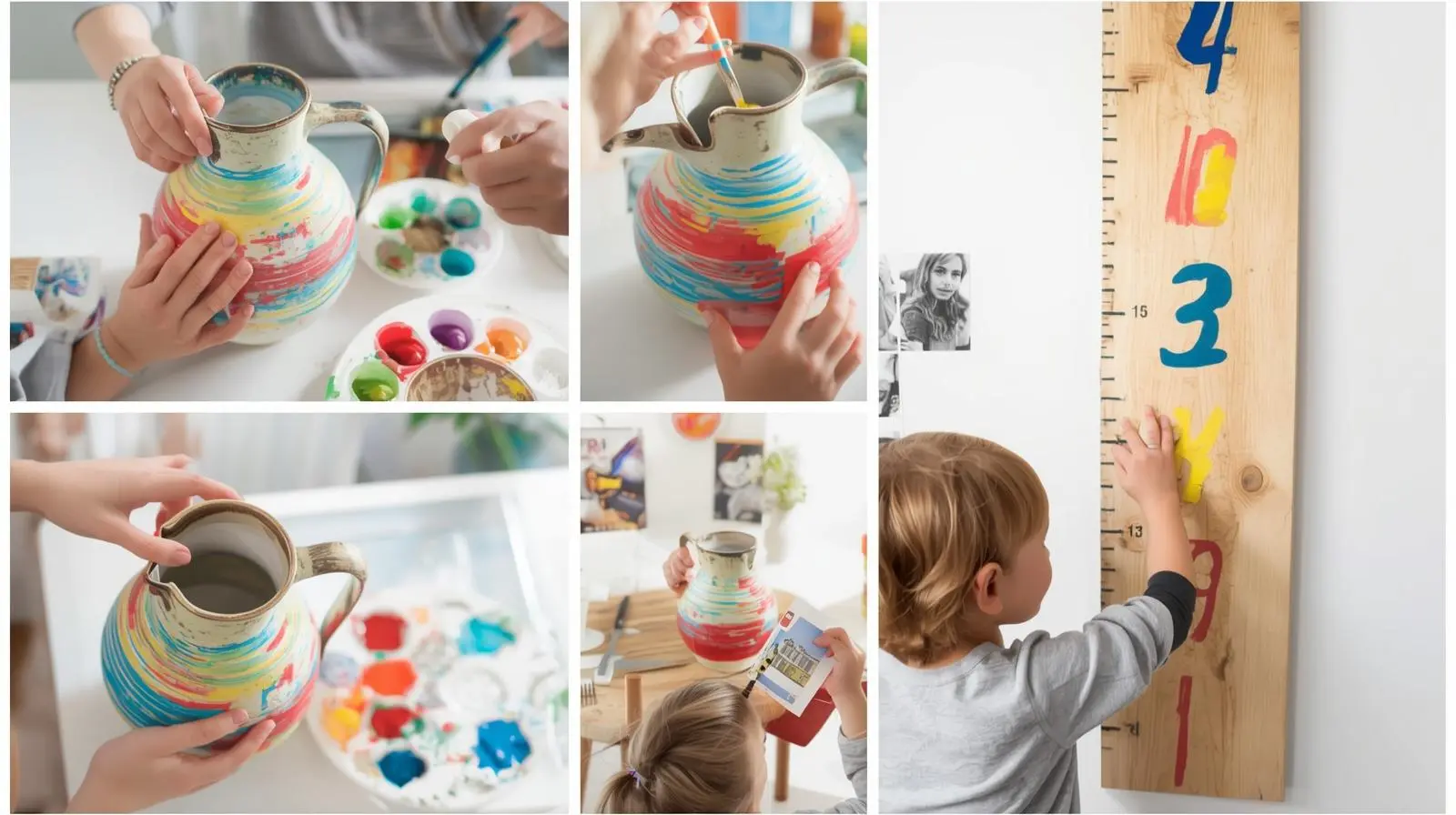
Maintenance and Longevity Tips
Designing a space is one thing keeping it looking beautiful and functioning well over time is another. These simple care tips help ensure your investment lasts, especially with children in the mix.
Cleaning & Care for Natural Materials
- Wood: Dust with a soft cloth and use gentle, natural cleaners. For unfinished or oiled wood, apply a plant-based oil (like linseed or coconut) occasionally to maintain hydration.
- Glass & Acrylic: Use microfiber cloths with non-abrasive cleaners. Avoid anything scratchy on acrylic surfaces.
- Ceramic & Metal Pitchers: Check manufacturer labels most ceramic pitchers are hand-wash only. Enamel or metal may be dishwasher safe.
💡 Expert Tip: Choose washable, durable fabrics for soft decor (rugs, curtains, cushions). It makes cleaning up spills and stains much easier.
🪑 Decor That Grows with Your Child
Kids grow fast but your furniture doesn’t have to become obsolete.
- Invest in high-quality wood pieces that can be sanded, refinished, or repainted as tastes change.
- Use neutral base colors (white, grey, wood tones) and swap out accessories like pillows or posters as your child matures.
- Choose modular furniture items that can be rearranged or repurposed for different functions over the years.
💡 Expert Tip: That low bookshelf? It may start as toy storage and later become a bedside bookcase or homework station.
Organizational Strategies for Long-Term Tidiness
A beautiful space only works if it’s easy to keep organized. Try these strategies to keep clutter at bay:
- Label storage bins with words or pictures for easy clean-up.
- Create a “home” for everything every toy, book, or marker should have a dedicated spot.
- Make tidying a routine. Set aside 10 minutes daily for cleanup, and involve your child with fun music or a reward system.
Conclusion: Creating a Home That Grows With Your Kids
Designing your child’s space isn’t just about filling a room it’s about shaping an environment where creativity, safety, and comfort live in harmony. By thoughtfully incorporating natural materials like wood and glass, and reimagining versatile items such as pitchers, you can create a home that feels as beautiful as it is functional.
From multi-purpose pitchers used for art supplies, to wooden furniture that evolves with your child, to glass accents that spark curiosity and wonder, each element contributes to a space that reflects both your style and your child’s needs. Safety doesn’t have to sacrifice beauty. With a few smart design choices, you can strike the perfect balance between aesthetic appeal and practical, child-friendly living.
🌿 The Value of Intentional Design
When you decorate with intention using materials that are durable, adaptable, and meaningful you build more than just a nice-looking space. You craft an environment that:
- Encourages imaginative play
- Supports organization and independence
- Grows alongside your child’s changing interests and abilities
This kind of space becomes a backdrop for family memories, a place where children feel seen, inspired, and truly at home.
Final Encouragement
Embrace the beauty of natural textures, the charm of repurposed items, and the joy of creating a room with your child in mind. Whether it’s a hand-painted pitcher holding pencils, or a wooden growth chart marking milestones, every piece can tell a story your family’s story.
You don’t need a designer budget to create a designer feel. What matters most is thoughtful intention, a touch of creativity, and the willingness to grow right alongside your little ones.

